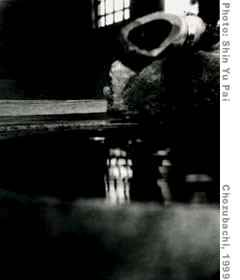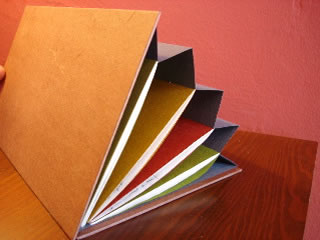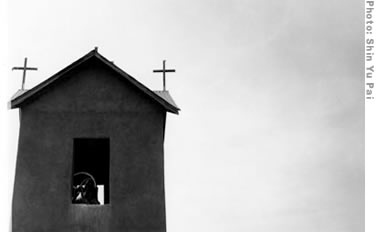
25 SEPT 06
an interview with Shin Yu Pai

Would you describe your publishing history--how did it all start and how did it progress?
I started publishing poems when I was a graduate student at the Naropa Institute in 1997. DIY publishing was encouraged and several classmates trained in the Harry Smith letterpress workshop on campus and started small publishing projects. I published poems early on through these little projects and Jerry Tumlinson, a poetics student and classmate in Anselm Hollo's translation workshop who started Third Ear Books, asked me for a manuscript of Chinese translations. He published my first chapbook, which I worked on with my father, Ten Thousand Miles of Mountains and Rivers, released in Summer 1998. Keith Abbott did the calligraphy, which was made into a plate that Brad O'Sullivan of Smokeproof Press used to letterpress the covers.

I was really grateful to Jerry for the respect and care he showed to the work--he involved me in all aspects of the design from end papers to binding. Because we felt it was important to present the work in a bilingual edition, he also found a printer who could print Chinese characters in San Francisco that he actually flew out to work with in person, as long-distance communication wasn't getting the job done. That book was produced in a limited-edition run of about 125 copies.

I published Equivalence in 2003 with La Alameda Press. Up to that point, I had published in small journals and began putting together a manuscript after finishing grad school in Chicago in 1999. I was sidetracked with work for a few years and got together a rough draft of Equivalence which I started sending out in 2001. Like a lot of poets, I started out by sending to contests. In retrospect, I would have bypassed that process and saved myself hundreds of dollars in reading fees--but I did not have a strong understanding of the publishing landscape at that time and didn't know my options.
In Spring 2002, I asked the advice of writers who had been meaningful to me at Naropa. Joanne Kyger suggested that I write to JB Bryan of La Alameda Press. La Alameda produces beautiful books within a certain literary and spiritual aesthetic--they had published many of my teachers at Naropa--Joanne, Andrew Schelling, and Anselm Hollo, alongside amazing New Mexico writers like Lisa Gill and Carol Moldaw. I sent the manuscript to La Alameda and a few months later, JB responded with a large package which included a sampling of La Alameda's titles and a warm and generous two-page letter accepting the work. I was deeply touched by his reading and attention to the work, and throughout my publishing experiences, my work and relationship with JB and his wife Cirrelda, has remained the gold standard.
What was also meaningful--during that waiting period to hear about the manuscript, I had spoken to my mentor and friend Andrew Schelling about the project. Andrew was working on production for his book Wild Form, Savage Grammar with La Alameda and offered to put in a good word with JB about my work. I received JB's acceptance that same week, but before my old friend had occasion to speak to JB. The decision had already been made on the merit of the work.
The process of working on Equivalence was a very collaborative one. I suggested the artwork for the cover, a painting by Boston artist Walker Buckner. Walker's a dear friend who I've known since my early 20s. By total random chance, JB knew of Walker's work, having read an article about his painting in an art magazine published several years earlier. All the synchronicities were great. JB also included one of my abstract black-and-white photographs of a Japanese chozubachi as the frontispiece for the collection.

Andrew consulted on the final sequence of the book, after I removed the section breaks at JB's suggestion to make the collection more seamless. We did a print run of 1,000, and of that original run, less than 100 copies remain.
I published my next chap, Unnecessary Roughness, in Spring 2005 with xPress(ed), a small publisher of experimental literature based in Finland, which has a strong internet presence. The press had been producing PDF e-books as downloads, but moving into the realm of printed matter. I was offered the option of producing the collection as a POD through Lulu. The cover artwork is a photo/text piece by NY artist Ferenc Suto, a friend and collaborator, and the only deliberate design choice that went into creating the book.
I'm not sure that I would do POD publishing again in the future--less than 50 copies of the book sold and there were no comp/author's copies offered as part of the publishing agreement. I purchased copies to send out for review and promotion when I discovered that there were few reviewers who were willing to work with a digital PDF of the book. POD pretty much eliminates your upfront production costs, but I was disheartened by the production quality--ink color and quality, mild pixelation on cover, paper weight, cover stock, etc. Nevertheless, the process was educational.

At the moment I'm in the final stages of working with Press Lorentz and with Convivio Bookworks on two separate projects. Press Lorentz is producing my Love Hotel Poems as a limited edition artist book, pairing my work with Danish paper artist Peter Callesen. We chose a hand-stitched binding for the book that mirrored the bindings used to bind together ledger books found in traditional Japanese inns.
Convivio Bookworks is doing a letterpress concertina-bound book of my Works on Paper--literally poems on the theme of paper--bound in boards that are wrapped in persimmon-dyed paper.

The project with Convivio was initiated in 2003--I've learned that making beautiful books can take a lot of time, and it's definitely worth it. I've been going back to working more closely with my publishers to create a more integrated vision. I care about the work too much to rush it anymore, and I believe that good design matters.

Also in production is Sightings: Selected Works (2000-2005) with Ahadada Books. I've been working on the concept with San Antonio designer Roland Murillo of Murillo Design. Roland's book designs came to my attention through poet Anthony Flores. I will be hand-carving into the covers with an exacto knife, cutting holes that will allow the reader to see through to the text on the title page. Through the whole design process, I've learned a great deal about getting a book printed. With future projects, I would like to continue to work directly with a chosen designer and manage the production process from start to finish. I'm not sure what that would look like, but I'm very interested at this time in moving to a cooperative publishing model--what's being done by groups like Tres Chicas.
In 2007, Tupelo Press is bringing out my Nutritional Feed project with painter David Lukowski. That's been a hands-off process so far. The press was awarded some NEA funding to help produce the collection. We'll see what develops.

How and why did you hook up with Tupelo for the Nutritional Feed project? Will they design and produce the book without your direct involvement?
In late Spring of 2004, I posted a query on the WOMPO list asking for recommendations for publishers with an interest in collaborative manuscripts, and/or works bringing together the visual and the textual. The founder and publisher of Tupelo Press backchanneled me and asked me to submit the two projects that I was working on to the press, independent of the contests that Tupelo runs. A few months later, he accepted Nutritional Feed. Because the costs of printing and producing a book with full-color art plates can be quite costly, and frankly, prohibitive for the budgets of the average small press, the press put the project on hold until it could explore funding opportunities. As of last month, I am told that the book will be scheduled for a Fall 2007 release.
I visited face-to-face with the publisher in Connecticut when I was on the East Coast for a UCONN reading in 2004. At that time, I had the opportunity to see a large number of the books that the press had produced. Tupelo makes a very beautiful book--high-quality paper and cover stocks, unique designs and varied formats, and signature French flaps--Barbara Tran's book and Anna Rabinowitz's Darkling particularly stood out to me. In speaking to the publisher, I came away with the sense that creating beautiful books and promoting emerging talent was central to their mission and that it could be a meaningful partnership.
Production hasn't yet begun, and it's difficult to say how the process will evolve. The press has asked for my feedback on what I'd like to see on the cover, but reserve the right to create something completely different. I have faith that the project will eventually come together--the press did a fine job with Mong Lan's recent book Why is the Edge Always Windy? which incorporated the poet's drawings into a larger-format book design, consistent with her first book. With the process of my three other projects currently in production, largely I'm grateful to have the process of this fourth project managed by a press that has a track record of producing attractive books.

Is your interest in independent publishing such that you consider publishing others?
I've contemplated it more than once. There are a handful of Naropa poets I've followed over the years whose work I am very committed to, whose work I would really love to see in the world. Publishing that work would take, of course, resources, and partnerships--because I'm not an expert in Quark or InDesign, and my personal passion has been poetry and marketing it, not book design. I don't have a lot of disposable income to do the kinds of things I would like to do for my own work right now, let alone for others. However, a step in that direction has been curating readings and inviting poets to submit work for small projects that I edit. There are many ways in which we can advocate and honor the work of those we admire and support--publishing being only one aspect of that gift economy. I do think that poets should take greater ownership of getting their work published and invest the efforts and energy into their own work to produce, on their own terms, beautiful books that they are directly involved in creating. There are alternative options out there to the mainstream and the established, and one need only become familiar with those options.
This Spring, I was on residency in Taipei and interviewed a number of contemporary poets for a special upcoming issue of Tony Tost's Fascicle. One thing that was interesting about getting to know the poetry publishing industry in Taiwan is that many poets "self-publish" their own work thru getting a first-book grant from the Council for Cultural Affairs and hand-picking a design firm to work with on the conceptualization of the book. The designers manage the production and printing. The poets then work with a separate agency to market the book and to get it into bookstores. That model makes sense to me. It's not that publishers of poetry in Taiwan don't exist, it's that they don't always provide the right form/container for the work. I'd say the same goes in American small press publishing. As far as I can tell, there is no stigma attached to self-publishing in Taiwan. Ye Mimi's self-published debut collection even won the Golden Butterfly Award for book design from the Taipei Book Foundation two years ago. Making a beautiful book in a cooperative spirit seems most important.

Though you've taken a less-traveled road with your books, you'll be reading at the Dodge Festival this month--a pretty mainstream gig. What are your feelings about the so-called mainstream?
The invitation to present my work at the Dodge Festival came as an unexpected surprise and I consider the opportunity a great gift. I'm looking forward to hearing Ko Un, Brian Turner, Natasha Trethewey, and Sholeh Wolpe at the Festival and presenting my own work to new audiences. [Shin Yu is scheduled to appear twice at the Dodge Festival, giving a talk on Thursday morning, September 28th, from 11:30 to 12:30, and reading on Sunday, October 1st, at 11.00 a.m.]
I don't know where my work fits within the "mainstream"--I think the poems of my early work Equivalence have a more accessible mainstream intellectual and aesthetic appeal. The book helped me get several speaking engagements at universities. But the Love Hotel series and sports poems of Unnecessary Roughness are much edgier and more in an anthropological tradition. Over 10 years ago, I worked for Agni, a very mainstream lit magazine, when I studied at B.U. That taught me a lot about what is and isn't getting published and what interests me. I don't generally spend time reading mainstream poetry or publications--Poetry Magazine or APR--although I do enjoy the work of Billy Collins, and I find the work of Robert Hass very beautiful.

Are you originally from Texas?
I was born in the Mid-West and grew up in the Inland Empire of So Cal. This is my second time living in Texas. I have been here since 2004, when I was offered a residency at the University of Texas at Dallas at Southside on Lamar that subsidized my living costs for a year and provided me with time to write. My husband is originally from the area and we have a small community here of healers and artists. I consider myself a Californian and that is where I locate "home," though I've spent most of my adult life living in Boston and other big cities. The west is the heart, and the mind is the East. I'm grateful to have known both.

Do you have something like an ordinary work day? On a Thursday, say, what do you do?
As of very recently, I've paid the bills by working as a freelance copyeditor/writer for a major daily newspaper in the Dallas-Fort Worth region. On a Thursday, I would be shoving real estate pages for weekend publication, cleaning up headlines, fixing widows, and fine-tuning real estate bloat by sending text through the "blander" to conform to AP and general style guidelines. Much is to be found in the happy accidents of real estate copy: "homes near the connivances (conveniences) of the city" and "family-friendly outings on FagpoleHill" (Flagpole Hill just happens to be a gay district). I don't know if anyone other than a word person would find these things amusing.

In one of your recent blog posts, you closed with "How much poetry remains a part of my long-term future remains to be seen." Does this reflect a desire to focus on other areas of expression?
I've given a lot of public readings and taught many workshops since publishing Equivalence in 2003. I am ready to take a break from finishing up old projects and shepherding them into the world. I am interested at this time in the clarification of intent and working towards something greater, which may or may not involve poetry as a central focus.
I'm starting a one-year yoga training program with my husband in November, through a local studio where I very much respect the work being done. I'm interested in the intersection between the healing arts and the literary/creative arts. There are connections and I'm starting to learn of healers who combine their work in poetry and yoga--among them artists like Karen X and Jeff Davis. My husband is an acupuncturist and we're interested in finding ways to bring our lives closer together. Other long-term opportunities for growth and learning are also on the horizon--I've wanted to go back to school for a long time to study anthropology formally, within an art school setting specifically. A very rare and exciting opportunity has been extended to me and I am contemplating what's possible.
:
Optometrist a poem by Shin Yu Pai from Nutritional Feed
[click here to enlarge]
. . .
next interview: Katy Henriksen
. . .
